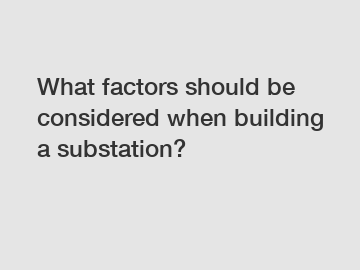What factors should be considered when building a substation?
Building a substation requires careful consideration of various factors to ensure efficiency, safety, and reliability. Substations are crucial components of the power grid, responsible for transforming voltage levels, enabling the distribution of electricity to consumers. When planning the construction of a substation, several key factors must be taken into account to ensure optimal performance and functionality. In this article, we will explore the factors that should be considered when building a substation.
Site Selection.
Selecting the right location for a substation is essential for its successful operation. Factors such as proximity to power sources, ease of access for maintenance, and environmental considerations must be taken into account. Ideally, a substation should be located close to where electricity is generated to minimize transmission losses. Additionally, the site should have adequate space for equipment installation, future expansion, and compliance with safety regulations.

Equipment Selection.
Choosing the right equipment for a substation is crucial for its efficient operation. Transformers, circuit breakers, disconnect switches, and other components must be selected based on capacity requirements, safety standards, and compatibility with the existing infrastructure. High-quality equipment from reputable manufacturers is essential to ensure reliability and longevity. Careful consideration should also be given to factors such as load capacity, insulation levels, and protection settings to meet operational needs.
Safety and Security.
Safety is a top priority when building a substation, as these facilities are high-voltage environments that pose significant risks to personnel and equipment. Proper grounding, fencing, signage, and access control measures must be in place to protect against electrical hazards, unauthorized access, and vandalism. Fire detection and suppression systems, as well as emergency response plans, should be implemented to mitigate potential risks and ensure the safety of personnel and the surrounding community.
Environmental Impact.
Substations can have environmental implications due to factors such as noise, electromagnetic fields, and visual impact. When selecting a site for a substation, environmental considerations must be taken into account to minimize its footprint and mitigate potential negative effects on the surroundings. Soundproofing measures, landscaping, and visual screening can help reduce noise and visual pollution, while proper design and layout can minimize electromagnetic emissions and their impact on nearby residents.
Regulatory Compliance.
Compliance with local, state, and federal regulations is critical when building a substation. Permitting requirements, zoning restrictions, environmental regulations, and safety standards must be carefully followed to ensure legal and regulatory compliance. Working with regulatory authorities, environmental agencies, and community stakeholders is essential to obtain the necessary approvals and permits for construction. Failure to comply with regulations can result in delays, fines, or even project shutdowns.
Conclusion.
In conclusion, building a substation requires careful consideration of various factors to ensure optimal performance, safety, and compliance. Site selection, equipment choice, safety measures, environmental impact, and regulatory compliance are all critical aspects that must be taken into account during the planning and construction process. By addressing these factors proactively and engaging with stakeholders, project managers can deliver substation projects that meet operational requirements and community expectations.
If you have any questions or need assistance with building a substation, please feel free to contact us. Our team of experts is here to help you plan, design, and construct substation facilities that meet your specific needs and requirements.
Contact us to discuss your requirements of small size outdoor prefabricated substation supplier, the differences between the fixed type and withdrawable type, metal clad switchgear. Our experienced sales team can help you identify the options that best suit your needs.



Comments
0